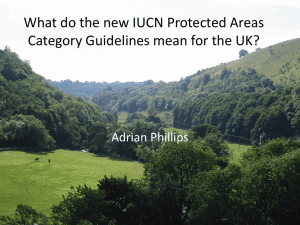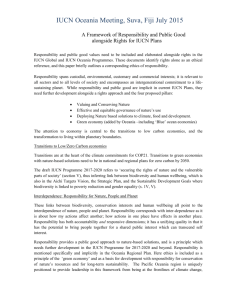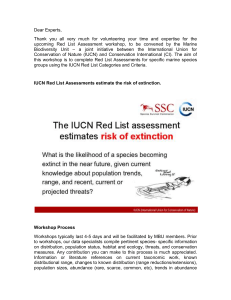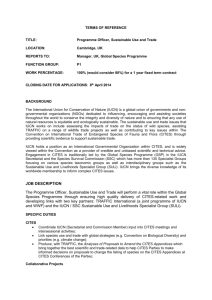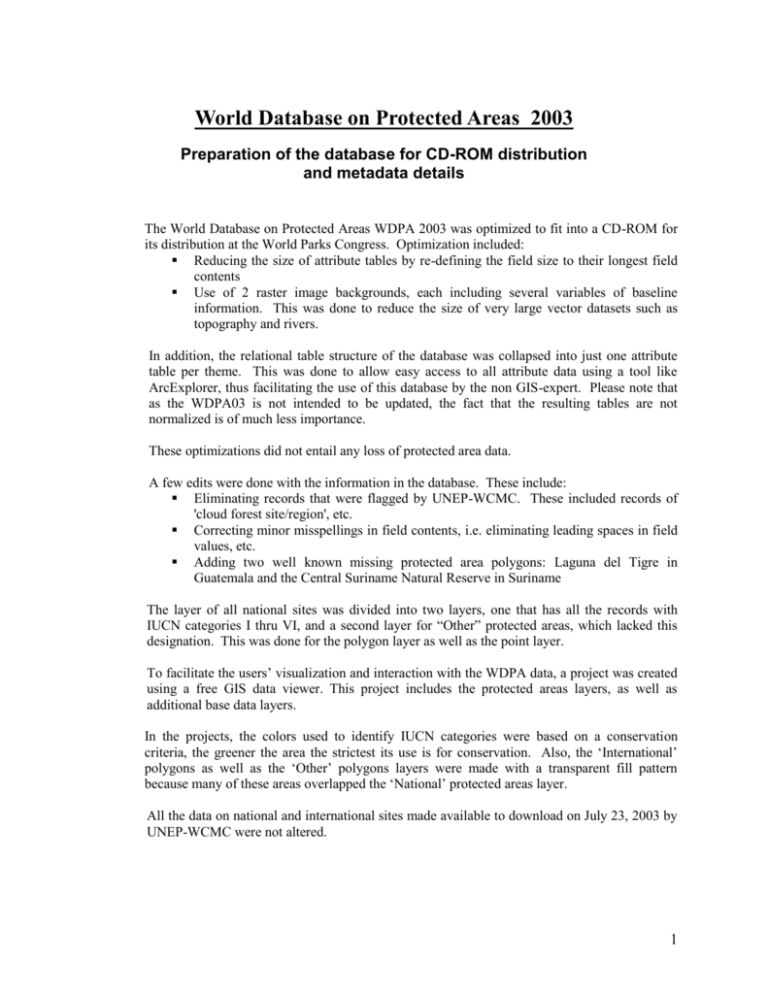
World Database on Protected Areas 2003
Preparation of the database for CD-ROM distribution
and metadata details
The World Database on Protected Areas WDPA 2003 was optimized to fit into a CD-ROM for
its distribution at the World Parks Congress. Optimization included:
Reducing the size of attribute tables by re-defining the field size to their longest field
contents
Use of 2 raster image backgrounds, each including several variables of baseline
information. This was done to reduce the size of very large vector datasets such as
topography and rivers.
In addition, the relational table structure of the database was collapsed into just one attribute
table per theme. This was done to allow easy access to all attribute data using a tool like
ArcExplorer, thus facilitating the use of this database by the non GIS-expert. Please note that
as the WDPA03 is not intended to be updated, the fact that the resulting tables are not
normalized is of much less importance.
These optimizations did not entail any loss of protected area data.
A few edits were done with the information in the database. These include:
Eliminating records that were flagged by UNEP-WCMC. These included records of
'cloud forest site/region', etc.
Correcting minor misspellings in field contents, i.e. eliminating leading spaces in field
values, etc.
Adding two well known missing protected area polygons: Laguna del Tigre in
Guatemala and the Central Suriname Natural Reserve in Suriname
The layer of all national sites was divided into two layers, one that has all the records with
IUCN categories I thru VI, and a second layer for “Other” protected areas, which lacked this
designation. This was done for the polygon layer as well as the point layer.
To facilitate the users’ visualization and interaction with the WDPA data, a project was created
using a free GIS data viewer. This project includes the protected areas layers, as well as
additional base data layers.
In the projects, the colors used to identify IUCN categories were based on a conservation
criteria, the greener the area the strictest its use is for conservation. Also, the ‘International’
polygons as well as the ‘Other’ polygons layers were made with a transparent fill pattern
because many of these areas overlapped the ‘National’ protected areas layer.
All the data on national and international sites made available to download on July 23, 2003 by
UNEP-WCMC were not altered.
1
Methods to package the WDPA launched and
distributed and at the World Parks Congress 2003.
WDPA Data Layers
The 2003 version of the WDPA on CD-ROM contains a total of 13 map layers of information, of
which seven layers focus on Protected Areas information. Six base layers provide context for visualizing
the protected area information.
The total list of layers as they appear on the left panel of Arc Explorer is the following:
1. COUNTRY BOUNDARIES
(polygon) - Outline of country boundaries including coastline
2. MAIN CITIES (point) - Large cities
3. POPULATED PLACES (point) - All populated places, from large cities to places that might
only include a few houses
4. NATIONAL IUCN PA BOUNDARIES (polygon) - Outline of National Protected Areas of
IUCN categories I through VI.
5. INTERNATIONAL SITES (POINT) - Sites recognized by one of 8 international conventions
or agreements: Biosphere Reserves, RAMSAR and World Heritage Sites, European Biogenetic
Reserves, Bird Directive and Habitat Directive Sites, and Barcelona and Helsinki Conventions
Sites
6. INTERNATIONAL SITES (POLYGON)
World Heritage Sites.
- Biosphere Reserves, RAMSAR sites, and
7. NATIONAL_OTHER AREAS (POINT)
- Other protected Areas or reserves being
recognized at the national level. This layer also includes proposed areas and areas with
incomplete information
8. NATIONAL_OTHER AREAS (POLYGON) - Other Protected Areas or reserves being
recognized at the national level. This layer also includes proposed areas and areas with
incomplete information
9. NATIONAL_IUCN PAS (POINT)
through VI
- Established Protected Areas of IUCN categories I
10. NATIONAL_IUCN_PAS (POLYGON) - Established Protected Areas of IUCN categories I
through VI
11. ELEVATION AND RIVERS (Image) - Image layer showing topographic variations every 500
meters and main rivers
12. ROADS (Image) - Image layer showing roads classified into main roads and other
13. LAND AREA (polygon) - Land area of the Earth
2
National and “Other” PAs IUCN category
Edits include:
The 'cloud forest site/region' records were deleted (UNEP-WCMC said they were an error)
Negative value site codes (exist in polygon layer only) were deleted
The ' (space) Unset' records were corrected.
Two protected areas were added: Laguna del Tigre, Central Suriname Natural Reserve.
In the downloaded geodatabase format, UNEP-WCMC provided the protected areas data and a few
supplemental attribute tables. For the shapefile created for the WDPA CD, some of these tables were
permanently joined.
For the ‘National’ point and polygon datasets:
The 'attributes' table was attached to both.
The 'source' table was attached to the polygon layer (the only one with the source_id field).
The ‘URL table’ was not attached.
The fields were optimized which means that a script was written and ran which found the length of the
maximum entry in each column, then a new field of that width was made, and copied the data over,
making each column the minimum width it needed to store all the records in that column.
The outcome:
National polygon layer with tables joined, fields optimized: 261 MB
National All Points layer with tables joined, fields optimized: 98 MB
Total size: 359 MB
Process to break down the pa's into 4 layers:
In each layer with all the areas, a field called 'statkeep,' was created. If the status did not meet the
'statkeep' criteria, this column got a "N". This includes status of degazetted, proposed, in preparation,
recommended, unknown, unset), the rest got a "Y".
Then in each layer with all the areas, a field called 'iucnkeep' was created, if IUCN cat was not I-VI, this
column got a "N" (Unset, Unknown, blank), the rest got a "Y".
Then, for each layer, the records with BOTH 'keep' fields as "Y" were copied to the '..iucn1to6..' subset
layer, the rest were copied to the '...other areas..' subset layer. This was done for both points and polygons.
In this way, the iucn1to6 layer was not only meeting the criteria for the IUCN code, but the status
designation as well. The 'other areas' layers contained everything else.
Size for all 4 layers was 360MB
International Protected Areas
The International parks were converted to shapefiles, one for points and one for polygons.
3
The ‘attribute’ table was joined to both of these layers, then the ‘source’ table was joined to the polygons
(only polygons need the ‘source’ table).
The ‘URL’ table was not joined.
Fields sizes were optimized, negative site codes were deleted, duplicate columns removed.
The total size was 14.6 MB for both.
Base layers
A Tiff image was made that combined elevation and major rivers, called ‘elevatio_and_rivers.tif’. This
was done because the raw datasets were too large to fit on the CD.
The rivers data used for the Tiff is from ESRI’s ‘ArcWorld’ dataset. The ArcWorld license was checked,
it stated that data itself cannot be distributed but hard copies made from the data can be distributed. It
was decided that that burning a tiff of the data would count as a 'hard copy' to be able to include these
data as rasters. For the image, the 'perennial' rivers and lakes from the ArcWorld dataset were
used/taken, rasterized it to the same 1km resolution as the elev. data and burnt it in. The dataset also
included intermittent rivers, reservoirs, salt pans, etc. However it was decided to leave these out to make
it simpler and the file smaller.
The data agreement still stated that we need to acknowledge the source for a hard copy, therefore
anything that included this map would have to give a citation to ESRI.
To convert the global elevation grid data, it was kept into a single tiff, permanently saved using a 500m
interval color scheme, i.e. the color changes every 500m change in elevation. This is much smaller than
using the grid data itself (29MB as tiff vs. 405MB as grid). Doing this process it lost the ability to have
the user query the grid, and displaying a legend. But with the colors as they are gives a sense of the terrain
and major features. The tiff is accompanied by a world file (same name, with ‘.tfw’ extension) this file is
needed to georeference the image.
The elevation data source is the GLOBE elevation data project, 1km resolution.
The final product of the project contains the base data, PA data, the 2 arcexplorer setups, and projects for
4 viewer types:
arcexplorer2
arcexplorer4
arcview3.2
arcgis8.2
The projects are named after the type of software it needs. All projects were created with relative paths, so
they could be moved anywhere, just by making sure to copy the whole folder, and avoid moving the
folders around. As long as the 'data' folder is beneath each project in the directory structure, it should
open.
It was found that the AE4 java version .axl does not allow the user to double-click the project shortcut to
start the program, therefore to open the project users will have to open AE4, then navigate to the project.
4
The remaining base data is data from NIMA’s VMAP0 1:1,000,000 product. Layers included are:
Country borders
Cities/populated places
Roads
The roads data in vector format was too big to fit on the CD, so a Tiff image was made of this data
instead.
Metadata details for the WDPA 2003
METADATA: WDPA 2003 NATIONAL IUCN PROTECTED AREAS POINT DATA
Content Citation:
Title of Content: National IUCN Protected Areas, Global
Type of Content: Downloadable Data
Content Publisher: WDPA Consortium, UNEP, IUCN
Publication Date: August 2003
Content Description:
Content Summary: Established Protected Areas of IUCN categories I through VI.
Content Purpose: To improve analysis and decision processes at many levels and scales and
advance the global agenda for conservation of biodiversity.
Content Status:
Progress: Final 2003 published version of the World Database on Protected Areas (WDPA).
Update Frequency: The central version of the WDPA is updated continuously. The published
version of
the WDPA is updated and made available on an annual basis.
Spatial Domain:
West Coordinate: -180.000000
East Coordinate: 179.999540
North Coordinate: 83.730000
South Coordinate: -55.983600
Coverage Area: Global
Content Keywords:
Theme Keywords: Protected Area, Conservation, environment
Place Keywords: Global
Spatial Data Information:
Data Type: Vector
Data Format: SDE Feature Class
Data Projection: GCS_WGS_1984
Data Scale: 1: 1 000 000
Access and Usage Information:
Access Constraints: None
5
Use Constraints: Non Commercial Use Only - Copyright © 2003 UNEP, IUCN - all rights
reserved.
METADATA: WDPA 2003 NATIONAL IUCN PROTECTED AREAS POLYGON DATA
Content Citation:
Title of Content: National IUCN Protected Areas, Global
Type of Content: Downloadable Data
Content Publisher: WDPA Consortium, UNEP, IUCN
Publication Date: August 2003
Content Description:
Content Summary: Established Protected Areas of IUCN categories I through VI.
Content Purpose: To improve analysis and decision processes at many levels and scales and
advance the global agenda for conservation of biodiversity.
Content Status:
Progress: Final 2003 published version of the World Database on Protected Areas (WDPA).
Update Frequency: The central version of the WDPA is updated continuously. The published
version of
the WDPA is updated and made available on an annual basis.
Spatial Domain:
West Coordinate: -180.000000
East Coordinate: 179.999540
North Coordinate: 83.730000
South Coordinate: -55.983600
Coverage Area: Global
Content Keywords:
Theme Keywords: Protected Area, Conservation, environment
Place Keywords: Global
Spatial Data Information:
Data Type: Vector
Data Format: SDE Feature Class
Data Projection: GCS_WGS_1984
Data Scale: 1: 1 000 000
Access and Usage Information:
Access Constraints: None
Use Constraints: Non Commercial Use Only - Copyright © 2003 UNEP, IUCN - all rights
reserved.
METADATA: WDPA 2003 INTERNATIONAL PROTECTED AREAS POINT DATA
Content Citation:
Title of Content: WDPA International Protected Areas, Global
Type of Content: Downloadable Data
6
Content Publisher: WDPA Consortium, UNEP, IUCN
Publication Date: August 2003
Content Citation:
Title of Content: WDPA International Protected Areas, Global
Type of Content: Downloadable Data
Content Publisher: WDPA Consortium, UNEP, IUCN
Publication Date: August 2003
Content Description:
Content Summary: Biosphere Reserves, RAMSAR sites, and World Heritage Sites.
Content Purpose: To improve analysis and decision processes at many levels and scales and
advance the global agenda for conservation of biodiversity.
Content Status:
Progress: Final 2003 published version of the World Database on Protected Areas (WDPA).
Update Frequency: The central version of the WDPA is updated continuously. The published
version of
the WDPA is updated and made available on an annual basis.
Spatial Domain:
West Coordinate: -163.423740
East Coordinate: 179.399520
North Coordinate: 81.441800
South Coordinate: -55.253210
Coverage Area: Global
Content Keywords:
Theme Keywords: Protected Area, Conservation, environment
Place Keywords: Global
Spatial Data Information:
Data Type: Vector
Data Format: SDE Feature Class
Data Projection: GCS_WGS_1984
Data Scale: 1: 1 000 000
Access and Usage Information:
Access Constraints: None
Use Constraints: Non Commercial Use Only - Copyright © 2003 UNEP, IUCN - all rights
reserved.
METADATA: WDPA 2003 INTERNATIONAL PROTECTED AREAS POLYGON DATA
Content Citation:
Title of Content: WDPA International Protected Areas, Global
Type of Content: Downloadable Data
Content Publisher: WDPA Consortium, UNEP, IUCN
Publication Date: August 2003
Content Description:
7
Content Summary: Sites recognized by one of 8 international conventions or agreements:
Biosphere Reserves, RAMSAR and World Heritage Sites, European Biogenetic Reserves, Bird
Directive and Habitat Directive Sites, and Barcelona and Helsinki Conventions Sites
Content Purpose: To improve analysis and decision processes at many levels and scales and
advance the global agenda for conservation of biodiversity.
Content Status:
Progress: Final 2003 published version of the World Database on Protected Areas (WDPA).
Update Frequency: The central version of the WDPA is updated continuously. The published
version of
the WDPA is updated and made available on an annual basis.
Spatial Domain:
West Coordinate: -167.890000
East Coordinate: 175.550000
North Coordinate: 80.000000
South Coordinate: -54.640000
Coverage Area: Global
Content Keywords:
Theme Keywords: Protected Area, Conservation, environment
Place Keywords: Global
Spatial Data Information:
Data Type: Vector
Data Format: SDE Feature Class
Data Projection: GCS_WGS_1984
Data Scale: 1: 1 000 000
Access and Usage Information:
Access Constraints: None
Use Constraints: Non Commercial Use Only - Copyright © 2003 UNEP, IUCN - all rights
reserved.
METADATA: OTHER NATIONAL PROTECTED AREAS POINT DATA
Content Citation:
Title of Content: Other National Protected Areas, Global
Type of Content: Downloadable Data
Content Publisher: WDPA Consortium, UNEP, IUCN
Publication Date: August 2003
Content Description:
Content Summary: This data layer contains all remaining records of national Protected Areas
point data that are not assigned both an IUCN classification and a "designated" status. This
layer contains some points that are listed as ‘Designated’ but without IUCN classification and
some with IUCN classification without being listed as ‘Designated.’ Non-designated areas can
correspond to areas that are not of categories I through VI, are being proposed for protection,
have been degazetted (are no longer considered protected areas), or areas with incomplete or
inaccurate information.
8
Content Purpose: To improve analysis and decision processes at many levels and scales and
advance the global agenda for conservation of biodiversity.
Content Status:
Progress: Final 2003 published version of the World Database on Protected Areas (WDPA).
Update Frequency: The central version of the WDPA is updated continuously. The published
version of
the WDPA is updated and made available on an annual basis.
Spatial Domain:
West Coordinate: -179.983330
East Coordinate: 179.350000
North Coordinate: 81.850000
South Coordinate: -82.600000
Coverage Area: Global
Content Keywords:
Theme Keywords: Protected Area, Conservation, environment
Place Keywords: Global
Spatial Data Information:
Data Type: Vector
Data Format: SDE Feature Class
Data Projection: GCS_WGS_1984
Data Scale: 1:1 000 000
Access and Usage Information:
Access Constraints: None
Use Constraints: Non Commercial Use Only - Copyright © 2003 UNEP, IUCN - all rights
reserved.
METADATA: OTHER NATIONAL PROTECTED AREAS POLYGON DATA
Content Citation:
Title of Content: Other National Protected Areas, Global
Type of Content: Downloadable Data
Content Publisher: WDPA Consortium, UNEP, IUCN
Publication Date: August 2003
Content Description:
Content Summary: This data layer contains all remaining records of national Protected Areas
point data that are not assigned both an IUCN classification and a "designated" status. This
layer contains some points that are listed as ‘Designated’ but without IUCN classification and
some with IUCN classification without being listed as ‘Designated.’ Non-designated areas can
correspond to areas that are not of categories I through VI, are being proposed for protection,
have been degazetted (are no longer considered protected areas), or areas with incomplete or
inaccurate information.
Content Purpose: To improve analysis and decision processes at many levels and scales
and advance the global agenda for conservation of biodiversity.
9
Content Status:
Progress: Final 2003 published version of the World Database on Protected Areas (WDPA).
Update Frequency: The central version of the WDPA is updated continuously. The published
version of
the WDPA is updated and made available on an annual basis.
Spatial Domain:
West Coordinate: -175.193800
East Coordinate: 178.577260
North Coordinate: 79.182210
South Coordinate: -46.653550
Coverage Area: Global
Content Keywords:
Theme Keywords: Protected Area, Conservation, environment
Place Keywords: Global
Spatial Data Information:
Data Type: Vector
Data Format: SDE Feature Class
Data Projection: GCS_WGS_1984
Data Scale: 1: 1 000 000
Access and Usage Information:
Access Constraints: None
Use Constraints: Non Commercial Use Only - Copyright © 2003 UNEP, IUCN - all rights
reserved.
Base Layers
The Base Layers include 2 raster images and 4 polygon or point layers. Raster images can only be
visualized one at a time and must be the bottom layer. You can overlay protected area or other vector
information on top of them. You cannot modify the way a raster image is rendered but you can control
a point or polygon layer colors, width and fill pattern (please see the tutorial).
Elevation and Rivers Elevation image is derived from The Global Land One-km Base
Elevation (GLOBE) Project data, classified by 500m contour intervals. Hydrography is data derived
from ESRI's ArcWorld 1:3 M dataset, perennial lakes and rivers data. Both datasets were overlayed
and rasterized to 1 Km resolution.
GLOBE Task Team and others (Hastings, David A., Paula K. Dunbar, Gerald M. Elphingstone, Mark
Bootz, Hiroshi Murakami, Hiroshi Maruyama, Hiroshi Masaharu, Peter Holland, John Payne, Nevin A.
Bryant, Thomas L. Logan, J.-P. Muller, Gunter Schreier, and John S. MacDonald), eds., 1999.
The Global Land One-kilometer Base Elevation (GLOBE) Digital Elevation Model, Version 1.0. National
Oceanic and Atmospheric Administration, National Geophysical Data Center, 325 Broadway, Boulder,
Colorado 80303, U.S.A. Digital data base on the World Wide Web and CD-ROMs.
Environmental Systems Research Institute. ArcWorld 1:3M. [machine readable data file]. ArcView
format. Redlands, CA: Environmental Systems Research Institute, [1999].
10
Country Borders, Roads, Major Cities and Populated Places are from
VMAP0 (Digital Chart of the World):
National Imagery and Mapping Agency, VMAP_1V10 - Vector Map Level 0 (Digital Chart of the World),
Fairfax, VA, Digital data base on the World Wide Web, downloaded May, 2002.
In order to save space, Roads was also rasterized to 1Km resolution.
11

